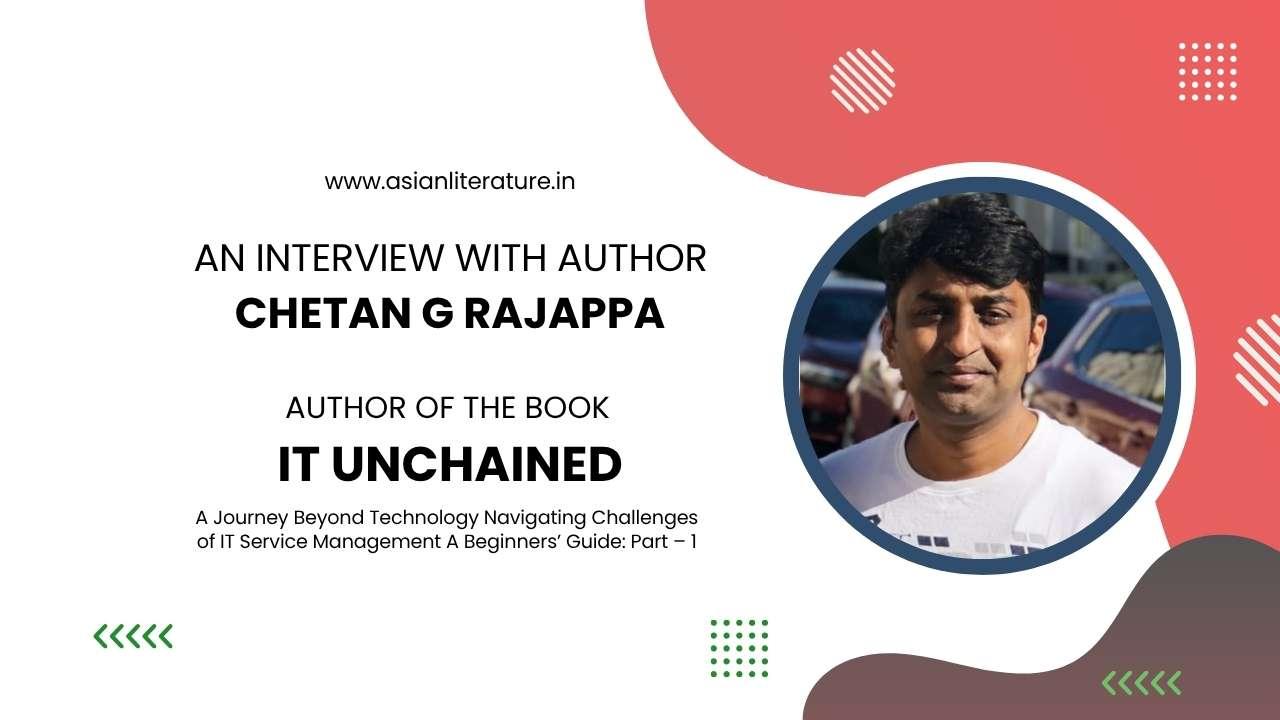
Inside IT Unchained: Chetan G Rajappa on truth, tech, and storytelling.
Title: IT Unchained
Author: Chetan G Rajappa
ISBN: 9789363557680
Publisher: Evincepub Publishing
About the Author: Chetan G Rajappa is a seasoned professional in IT Delivery, Service, and Quality Management, with over two decades of experience across various sectors. With a background in engineering and a postgraduate degree in Operations Management, he brings a grounded, execution-focused approach to aligning business needs with technology delivery.
He specializes in project delivery, service management, process design, business reengineering, and digital transformation-contributing to the evolution of IT delivery models through practical, results-driven strategies. His work spans the implementation of global standards and frameworks such as ISO, CMMI, Six Sigma, and ITIL, supporting organizations in achieving service excellence, process maturity, and operational transformation.
Beyond his professional role, Chetan is an avid stock market enthusiast with a focus on value investing. As a farmer’s son, he remains deeply connected to his agricultural roots and has been part of a couple of agri-based ventures-exploring ways to blend traditional practices with modern entrepreneurial ideas. These experiences continue to shape his perspective on innovation, sustainability, and adaptability.
IT Unchained is his debut novel-offering a blend of practical insights into IT Service Management with a compelling narrative that explores the human and technical challenges shaping today’s digital landscape.
Question – Your book IT Unchained is a unique mix of fiction and real IT challenges. What inspired you to write it this way?
Answer – After spending nearly two decades in IT service delivery, I realized that most frameworks talk about process but not people. I didn’t want to write another textbook. I wanted to tell the truth behind the IT Service management transformation — the pressure, politics, fatigue, and resilience of people who keep systems running. Fiction gave me the freedom to reveal real struggles, with enough disguise to protect people but still honor the emotion.
Question – Agastya Raj, the main character, feels very real. Is he based on someone you know—or perhaps yourself?
Answer – Agastya is a mirror. A mix of my own journey and the hundreds of IT professionals I’ve worked with. He’s not perfect. He doubts himself, questions the system, but still shows up; just like many of us. Through him, I wanted to voice what a lot of people feel but never say aloud.
Question – The book highlights the emotional side of IT jobs. Why was it important for you to show that side?
Answer – Because nobody talks about it. We discuss SLAs and KPIs, but not the anxiety of missing family events due to a Sev1, or the burnout from weekend deployments. The emotional cost of IT is invisible; yet very real. This book is my attempt to acknowledge and validate those silent battles.
Question – What was the most difficult part of writing this book—technical accuracy, storytelling, or something else?
Answer – Staying honest, without sounding bitter. It was hard to expose broken systems and painful truths, especially from within. Balancing emotional authenticity with hopeful storytelling was the tightrope.
Question – You’ve worked in IT for over two decades. How did your real-life experiences shape the story?
Answer – Every chapter has a piece of lived reality; escalations I’ve/team handled, team dynamics I’ve/team navigated, leadership dilemmas I’ve witnessed. Even the humorous parts come from real hallway conversations. This book wasn’t imagined — it was remembered.
Question – Many IT professionals deal with burnout and pressure. What message do you hope they take from your book?
Answer – That they’re not alone and that their pain is valid. And more importantly, that change is possible. It may not come from a tool or a new process, but from courageous conversations, empathy-led leadership, and reclaiming purpose.
Question – The book talks about juniorization, shift fatigue, and broken SLAs. Why did you choose to highlight these “less talked about” issues?
Answer – Because these are the things that slowly break teams not tech issues, but structural and cultural ones. Juniorization without mentorship, back-to-back shifts without rest, SLAs that serve dashboards but not users, these are silent killers of morale. Someone needed to say it.
Question – What role do you think empathy plays in successful IT service management?
Answer – It’s the most underrated skill. You can have the best ITIL processes, but if your team feels invisible, it’ll show up in your attrition and customer experience. Empathy helps translate incidents into impact; it humanizes service.
Question – How did your background in process design and quality management help you as a writer?
Answer – It taught me how systems work and more importantly, where they break. I could see patterns, gaps, and contradictions between what we say and what we do. That analytical lens helped me write with clarity, while still weaving a story.
Question – Were there any scenes or chapters that were especially emotional or personal for you while writing?
Answer – Yes, the chapter where Agastya’s team breaks down after a failed migration. That moment of raw vulnerability, followed by collective recovery, was inspired by a real incident. Writing it felt like reliving it.
Question – Your book can be used in team discussions, workshops, and training. Did you plan it that way from the beginning?
Answer – Not initially. But once I saw early readers using chapters in retrospectives and skip-level meetings, I realized it could be more than a story. It could be a tool to spark dialogue and drive reflection in teams.
Question – Do you think storytelling can help improve leadership and team engagement in IT companies? How?
Answer – Absolutely. Stories bypass defensiveness. When leaders share stories or listen to them, they build trust. A story can make someone say, “That’s me,” which is far more powerful than a metric ever can be.
Question – What feedback have you received from readers so far—especially from IT professionals?
Answer – The most common response is: “This is exactly what we go through, but no one ever writes about it.” Some said its reflection; some shared it with their managers. Many felt seen and that’s the highest compliment I could receive.
Question – Will there be a Part 2 of IT Unchained? If yes, what can readers expect in the next part?
Answer – Yes, there will be a Part 2, though I plan to take a short break as I’m currently leading delivery and transformation initiatives full-time. While the first book explored ITSM chaos, burnout, and transformation from the inside, the next will turn the lens outward into the real-world friction between vendors, legacy vs. modern IT, and AI’s growing influence.
It will also dive deeper into strategy, service design, and the often-forgotten improvement phases touching on DevOps realities, leadership dilemmas, and what it truly takes to scale without losing soul.
Question – Lastly, what advice would you give to IT professionals who want to write their own stories or share their experiences?
Answer – Start small, a note, a post, a blog, a moment that stayed with you. Don’t worry about structure or who’s watching. Just be honest. The IT world is full of untold stories and yours might be the one someone else needed to feel less alone.

